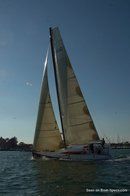JPK 40
Sailboat specifications
The JPK 40 is a 40’ (12.18m) racing sailboat designed by Jacques Valer (France). She was built since 2007 (and now discontinued) by JPK (France).
JPK 40's main features
- Model
- JPK 40
- Hull type
- Monohull
- Category
- Offshore racing sailboat
- Sailboat builder
- Sailboat designer
- Sailboat collection
- Country
- France
- Construction
- GRP (glass reinforced polyester):
Sandwich PVC fiberglass vinylester (vacuum infusion) - First built hull
- 2007
- Last built hull
- Discontinued
- Appendages
- Keel : fin with bulb
- Helm
- Twin tillers
- Rudder
- Twin spade rudders
- Unsinkable
- No
- Trailerable
- No
- EC design categoryiThe CE design category indicates the ability to cope with certain weather conditions (the sailboat is designed for these conditions)
A: Wind < force 9, Waves < 10m
B: Wind < force 8, Waves < 8m
C: Wind < force 6, Waves < 4m
D: Wind < force 4, Waves < 0,5m - A
- Standard public price ex. VAT (indicative only)
- About198 000 €(2008)
JPK 40's main dimensions
- Hull length
- 40’12.18 m
- Waterline length
- 40’12.18 m
- Beam (width)
- 14’ 1”4.3 m
- Draft
- 9’ 10”3 m
- Light displacement (MLC)
- 10141 lb4600 kg
- Ballast weight
- 4519 lb2050 kg
- Ballast type
- Steel fin with lead bulb
- Water ballast
- Lateral water ballasts
- Water ballast capacity
- 2198.1 gal750 liters
JPK 40's rig and sails
- Upwind sail area
- 1238 ft²115 m²
- Downwind sail area
- 2960 ft²275 m²
- Mainsail area
- 807 ft²75 m²
- Solent area
- 431 ft²40 m²
- Asymmetric spinnaker area
- 2153 ft²200 m²
- Rigging type
- Sloop Marconi 9/10
- Mast configuration
- Keel stepped mast
- Rotating spars
- No
- Number of levels of spreaders
- 2
- Spreaders angle
- Swept-back
- Spars construction
- Carbon fiber mast and aluminum boom
- Standing rigging
- 1x19 strand wire
JPK 40's performances
- Upwind sail area to displacementiThe ratio sail area to displacement is obtained by dividing the sail area by the boat's displaced volume to the power two-thirds.
The ratio sail area to displacement can be used to compare the relative sail plan of different sailboats no matter what their size.
Upwind: under 18 the ratio indicates a cruise oriented sailboat with limited performances especially in light wind, while over 25 it indicates a fast sailboat. - 448 ft²/T41.58 m²/T
- Downwind sail area to displacementiThe ratio sail area to displacement is obtained by dividing the sail area by the boat's displaced volume to the power two-thirds.
The ratio sail area to displacement can be used to compare the relative sail plan of different sailboats no matter what their size. - 1070 ft²/T99.42 m²/T
- Displacement-length ratio (DLR)iThe Displacement Length Ratio (DLR) is a figure that points out the boat's weight compared to its waterline length. The DLR is obtained by dividing the boat's displacement in tons by the cube of one one-hundredth of the waterline length (in feet).
The DLR can be used to compare the relative mass of different sailboats no matter what their length:
a DLR less than 180 is indicative of a really light sailboat (race boat made for planning), while a DLR greater than 300 is indicative of a heavy cruising sailboat. - 72
- Ballast ratioiThe Ballast ratio is an indicator of stability; it is obtained by dividing the boat's displacement by the mass of the ballast. Since the stability depends also of the hull shapes and the position of the center of gravity, only the boats with similar ballast arrangements and hull shapes should be compared.
The higher the ballast ratio is, the greater is the stability. - 45 %
- Critical hull speediAs a ship moves in the water, it creates standing waves that oppose its movement. This effect increases dramatically the resistance when the boat reaches a speed-length ratio (speed-length ratio is the ratio between the speed in knots and the square root of the waterline length in feet) of about 1.2 (corresponding to a Froude Number of 0.35) . This very sharp rise in resistance, between speed-length ratio of 1.2 to 1.5, is insurmountable for heavy sailboats and so becomes an apparent barrier. This leads to the concept of "hull speed".
The hull speed is obtained by multiplying the square root of the waterline length (in feet) by 1.34. - 8.47 knots
JPK 40's auxiliary engine
- Engine(s)
- 1 inboard engine
- Engine(s) power
- 30 HP
JPK 40's accommodations and layout
- Cockpit
- Open aft cockpit
- Berth(s)
- 2
Similar sailboats that may interest you:
Sailboats
First built hull
Hull length
2003
33’ 2”10.11 m
2016
45’ 4”13.8 m
2014
40’12.19 m
2017
32’9.75 m
2014
40’12.18 m
2009
40’12.18 m
2017
40’12.2 m
2010
38’ 8”11.8 m
2014
40’12.2 m
2015
45’ 1”13.75 m
2006
42’ 7”12.98 m
2006
42’ 7”12.98 m
2019
37’ 1”11.3 m
2014
32’ 10”9.99 m
2008
32’ 8”9.98 m








